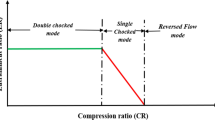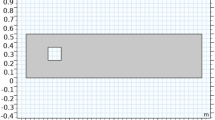Abstract
Thermal vapor compressor (TVC) is a device for compressing vapor in water–steam cycles and frequently used in desalination systems. Large amounts of useless vapor can be compressed by this device and the efficiency of a desalination unit is effectively enhanced through this process. Motive steam is injected into the TVC through a convergent–divergent nozzle and accelerated to supersonic velocities. The low pressure steam is entrained at the upstream zone and mixed with this highly compressible motive flow within the TVC. In the current study, the flow field of an experimental TVC is scrutinized in both axisymmetric and three-dimensional approaches and compared with experimental measurements. Since the steam collector at the suction surface of the TVC has a curved shape and may undermine the symmetry of the flow on either side of the central axis, the second objective of this study is to reveal the deviation of the symmetric assumption from the real non-symmetric condition of entering steam flow into the TVC. Results show that the presence of a bending at the inlet side has approximately negligible effects on the mixing phenomenon and the flow remains symmetric around the central axis. Hence, there is no need to consider the collector geometry in further simulations and the performance parameters of the TVC would be sufficiently obtained through an axisymmetric method with a substantial reduction in the computational cost and time.












Similar content being viewed by others
Abbreviations
- CR :
-
Compression ratio
- ER :
-
Entrainment ratio
- g :
-
Gravitational acceleration
- k :
-
Turbulence kinetic energy
- p :
-
Static pressure
- P :
-
Total pressure
- Q :
-
Mass flow rate
- R :
-
Gas constant
- T :
-
Temperature
- V :
-
Velocity component
- x :
-
Independent variable
- y :
-
Dependent variable
- ε :
-
Turbulence dissipation rate
- ρ :
-
Density
- μ :
-
Dynamic viscosity
- θ :
-
Tangential coordinate
- σ :
-
Turbulence Prandtl number
- τ :
-
Shear stress tensor
- in :
-
Inlet stream
- out :
-
Outlet stream
- d :
-
Discharge flow
- p :
-
Primary (motive) flow
- s :
-
Secondary (suction) flow
- r :
-
Radial coordinate
- z :
-
Axial coordinate
- i :
-
Dummy index
References
Ji MK, Utomob T, Woo JS, Lee YH, Jeong HM, Chung HS (2010) CFD investigation on the flow structure inside thermo vapor compressor. Energy 35:2694–2702
Huang BJ, Chang JM, Wang CP, Petrenko VA (1999) A 1-D analysis of ejector performance. Int J Refrig 22:354–364
Sun DW (1995) Recent developments in the design theories and applications of ejectors—a review. J Inst Energy 68:65–79
Riffat SB, Gan G, Smith S (1996) Computational fluid dynamics applied to ejector heat pumps. Appl Therm Eng 16:291–297
Riffat SB, Omer SA (2001) CFD modeling and experimental investigation of an ejector refrigeration system using methanol as the working fluid. Int J Energy Resour 25:115–128
Desevaux P, Aeschbacher O (2002) Numerical and experimental flow visualization of the mixing process inside an induced air ejector. Int J Turbo Jet Engine 19:71–78
Sriveerakul T, Aphornratana S, Chunnanond K (2007) Performance prediction of steam ejector using computational fluid dynamics: part 1. Validation of the CFD results. Int J Therm Sci 46:812–822
Sriveerakul T, Aphornratana S, Chunnanond K (2007) Performance prediction of steam ejector using computational fluid dynamics: part 2. Flow structure of a steam ejector influenced by operating pressures and geometries. Int J Therm Sci 46:823–833
Pianthong K, Seehanam W, Behnia M, Sriveerakul T, Aphornratana S (2007) Investigation and improvement of ejector refrigeration system using computational fluid dynamics technique. Energy Convers Manage 48:2556–2564
Bartosiewicz Y, Aidoun Z, Desevaux P, Mercadier Y (2005) Numerical and experimental investigations on supersonic ejectors. Int J Heat Fluid Flow 26:56–70
Bartosiewicz Y, Aidoun Z, Mercadier Y (2006) Numerical assessment of ejector operation for refrigeration applications based on CFD. Appl Therm Eng 26(5–6):604–612
Hemidi A, Henry F, Leclaire S, Seynhaeve JM, Bartosiewicz Y (2009) CFD analysis of a supersonic air ejector. Part I: experimental validation of single-phase and two-phase operation. Appl Therm Eng 29:1523–1531
Park IS (2009) Robust numerical analysis based design of the thermal vapor compressor shape parameters for multi-effect desalination plants. Desalination 242:245–255
Kouhikamali R, Sharifi N (2012) Experience of modification of thermo-compressors in multiple effects desalination plants in Assaluyeh in IRAN. Appl Therm Eng 40:174–180
Park IS, Park SM, Ha JS (2005) Design and application of thermal vapor compressor for multi-effect desalination plant. Desalination 182:199–208
Sharifi N, Boroomand M (2013) An investigation of thermo-compressor design by analysis and experiment: part 1. Validation of the numerical method. Energy Convers Manag 69:217–227
Sharifi N, Boroomand M (2013) An investigation of thermo-compressor design by analysis and experiment: part 2. Development of design method by using comprehensive characteristic curves. Energy Convers Manag 69:228–237
Sharifi N, Boroomand M (2012) Numerical optimization of thermo-compressors based on non-dimensional geometrical parameters, ASME 2012 Gas Turbine & Compressors conference, GTIndia 2012-9701
Sharifi N, Boroomand M, Kouhikamali R (2012) Wet steam flow energy analysis within thermo-compressors. Energy 47:609–619
FLUENT 6.3 User’s guide, FLUENT INC. Lebanon, NH, USA
Acknowledgments
The experimental data is based upon test facilities supported by the Fan-Niroo Company and the author also wishes to acknowledge the contributions of this work.
Author information
Authors and Affiliations
Corresponding author
Rights and permissions
About this article
Cite this article
Sharifi, N. Axisymmetric and three dimensional flow modeling within thermal vapor compressors. Heat Mass Transfer 49, 1489–1501 (2013). https://doi.org/10.1007/s00231-013-1187-y
Received:
Accepted:
Published:
Issue Date:
DOI: https://doi.org/10.1007/s00231-013-1187-y




